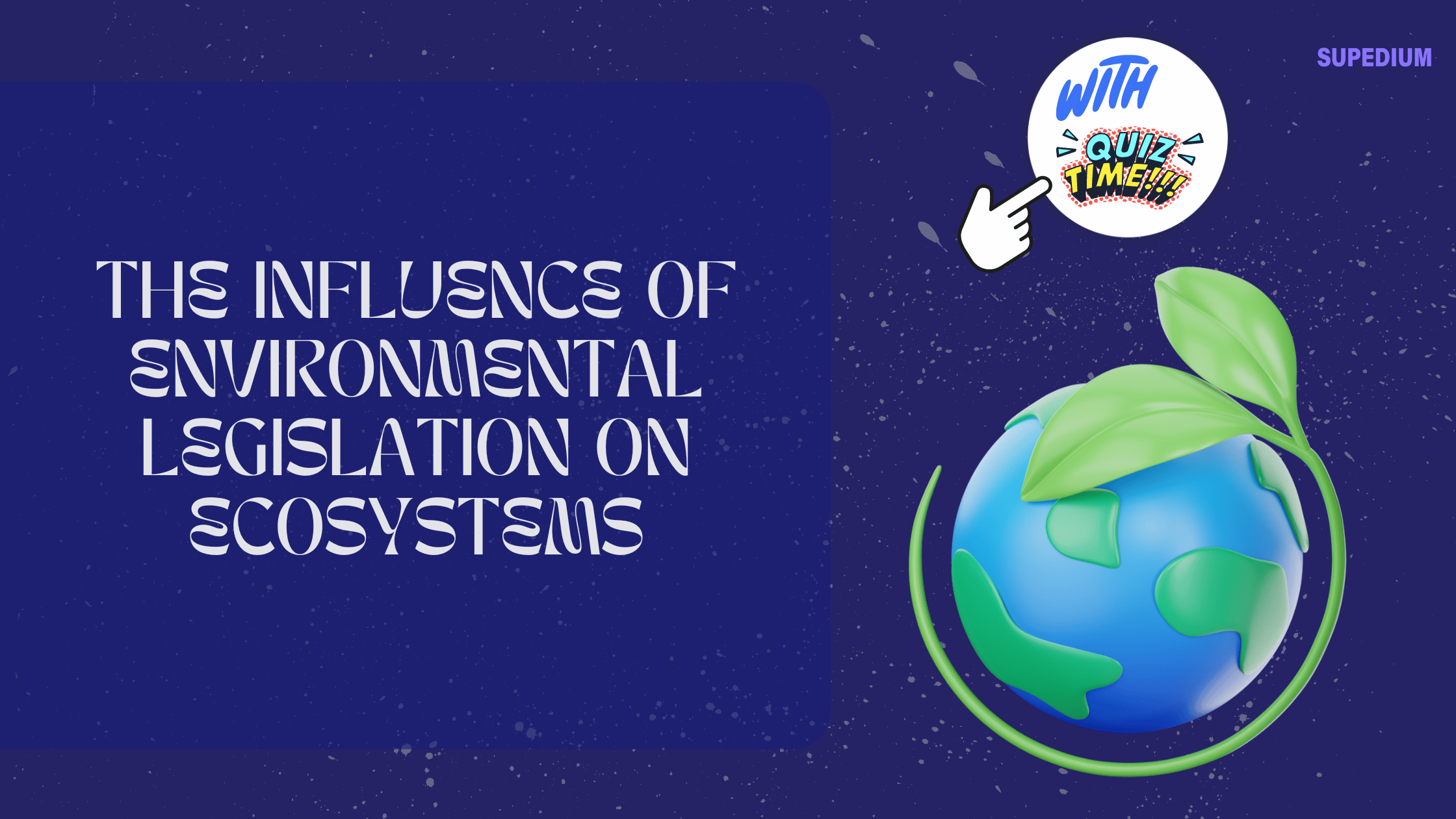Table of Contents
- 1 Introduction
- 2 Historical Context of Environmental Legislation
- 3 Mechanisms of Environmental Legislation
- 4 Positive Impacts of Environmental Legislation on Ecosystems
- 5 Negative Impacts of Environmental Legislation on Ecosystems
- 6 Case Studies
- 7 Future Directions in Environmental Legislation
- 8 Conclusion
- 9 Quiz Time
![]()
Introduction
Environmental legislation encompasses a range of laws and regulations designed to safeguard the natural environment from various forms of degradation and pollution. These legal frameworks aim to protect air and water quality, conserve natural habitats, and preserve biodiversity. Ecosystems, defined as the complex networks of interactions among living organisms and their physical surroundings, are deeply affected by these legislative measures. This article explores how environmental legislation influences ecosystems, assessing both its positive and negative impacts.
Historical Context of Environmental Legislation
Early Environmental Laws
The history of environmental legislation dates back to early attempts to manage pollution and protect natural resources. In the 19th century, the Industrial Revolution brought significant environmental changes, including increased air and water pollution. Early laws focused primarily on controlling visible pollutants and managing industrial waste. For instance, the UK’s Public Health Act of 1848 addressed sanitary conditions and public health concerns, laying the groundwork for more comprehensive environmental regulations.
The Environmental Movement of the 1960s-70s
The modern environmental movement gained momentum in the 1960s and 1970s, driven by growing awareness of environmental degradation. Key events such as the publication of Rachel Carson’s “Silent Spring” in 1962 highlighted the dangers of pesticide use and its impact on ecosystems. The first Earth Day, celebrated in 1970, galvanized public support for environmental issues. This period saw significant legislative milestones, including the National Environmental Policy Act (NEPA) of 1970 in the United States, which mandated environmental impact assessments for federal projects.
Evolution of Environmental Legislation
Since the 1970s, environmental legislation has evolved to address a broader range of issues. The scope of regulations expanded to include climate change, hazardous waste management, and biodiversity conservation. International agreements, such as the Paris Agreement on climate change and the Convention on Biological Diversity, reflect the global nature of environmental challenges and the need for cooperative solutions.
Mechanisms of Environmental Legislation
Regulatory Framework
Environmental legislation operates through a complex regulatory framework involving various government agencies. In the United States, the Environmental Protection Agency (EPA) is a key federal body responsible for enforcing environmental laws. Regulations may include setting standards for air and water quality, issuing permits for industrial activities, and monitoring compliance. State and local agencies also play crucial roles in implementing and enforcing regulations tailored to regional environmental issues.
Enforcement and Compliance
Effective enforcement and compliance mechanisms are vital to the success of environmental legislation. Agencies conduct inspections, monitor emissions and discharges, and assess environmental impacts to ensure that regulations are followed. Penalties for non-compliance can include fines, sanctions, and required corrective actions. Additionally, incentives such as tax breaks or grants may encourage businesses and individuals to adopt environmentally friendly practices.
Public Participation and Advocacy
Public participation is a critical aspect of environmental legislation. Non-governmental organizations (NGOs) and citizen groups often advocate for stronger environmental protections and hold policymakers accountable. Public comment periods allow citizens to provide feedback on proposed regulations, ensuring that diverse perspectives are considered. Engaging stakeholders in environmental decision-making helps to build support for and improve the effectiveness of legislation.
Positive Impacts of Environmental Legislation on Ecosystems
Air Quality Improvement
One of the most notable successes of environmental legislation is the improvement in air quality. Laws such as the Clean Air Act have significantly reduced the levels of pollutants like sulfur dioxide and nitrogen oxides. These reductions have led to better respiratory health for humans and improved conditions for wildlife. Cleaner air also benefits ecosystems by reducing the incidence of acid rain, which can damage forests, lakes, and rivers.
Water Quality Protection
Environmental regulations have made substantial contributions to improving water quality. The Clean Water Act, for example, has helped reduce pollution from industrial runoff, sewage, and agricultural practices. Enhanced water quality supports the recovery of aquatic habitats and the resurgence of various fish and plant species. Restoration projects funded by environmental legislation have rehabilitated wetlands and river systems, fostering healthier and more resilient aquatic ecosystems.
Habitat Conservation and Species Protection
Environmental legislation has played a crucial role in conserving habitats and protecting endangered species. Laws such as the Endangered Species Act have facilitated the creation of protected areas like national parks and wildlife refuges. These protections have been instrumental in the recovery of species such as the bald eagle and the American alligator. By preserving critical habitats and regulating human activities, legislation helps maintain biodiversity and ecosystem stability.
Negative Impacts of Environmental Legislation on Ecosystems
Unintended Consequences
Despite its benefits, environmental legislation can sometimes lead to unintended consequences. For example, pollution controls may shift pollutants from one medium to another, such as from air to water. In some cases, stricter regulations can drive industries to relocate, resulting in economic disruptions and potential environmental impacts in other regions. Addressing these issues requires careful consideration and adaptive management strategies.
Over-regulation and Bureaucracy
Over-regulation and bureaucratic inefficiencies can hinder the effectiveness of environmental legislation. Small businesses and local economies may struggle with the costs and complexities of compliance. Delays in regulatory processes and excessive paperwork can also impede timely environmental protection efforts. Streamlining regulations and reducing administrative burdens can help balance environmental goals with economic considerations.
Conflicts of Interest
Conflicts of interest can influence environmental legislation, particularly when industry lobbyists exert pressure on policymakers. Compromises made to accommodate business interests may weaken environmental protections or delay necessary reforms. Ensuring transparency and accountability in the legislative process is essential to prevent such conflicts from undermining environmental objectives.
Case Studies
The Clean Air Act and Urban Air Quality
The Clean Air Act has been instrumental in improving air quality in major cities across the United States. By setting emission standards for vehicles and industrial sources, the Act has significantly reduced pollutants like ozone and particulate matter. Urban ecosystems have benefited from cleaner air, resulting in healthier vegetation and reduced respiratory issues among residents.
The Endangered Species Act and Species Recovery
The Endangered Species Act has led to the successful recovery of several endangered species. The bald eagle, once on the brink of extinction, has rebounded thanks to habitat protection and restrictions on pesticide use. Similarly, the American alligator’s recovery demonstrates the positive impact of legal protections on species populations. However, challenges remain, such as balancing conservation efforts with land use and development needs.
The Clean Water Act and Aquatic Ecosystems
The Clean Water Act has improved water quality and supported the recovery of aquatic ecosystems. By regulating discharges from point sources and promoting water conservation, the Act has enhanced the health of rivers, lakes, and wetlands. Despite progress, ongoing issues like nutrient pollution and habitat degradation require continued attention and innovation in water management.
Future Directions in Environmental Legislation
Emerging Environmental Issues
Environmental legislation must address emerging issues such as climate change and plastic pollution. Climate change poses significant risks to ecosystems, including shifts in species distributions and increased frequency of extreme weather events. Plastic pollution, including microplastics, threatens marine life and requires innovative regulatory approaches to mitigate its impact.
Innovations in Legislation
Future environmental legislation may incorporate market-based approaches, such as carbon trading and emissions reduction credits. These mechanisms aim to provide economic incentives for reducing environmental impacts. Additionally, integrating environmental justice and equity considerations into legislation ensures that vulnerable communities receive protection and support.
International Cooperation and Global Legislation
International cooperation is crucial for addressing global environmental challenges. Treaties and agreements, such as the Paris Agreement, highlight the need for collaborative efforts to combat climate change and protect biodiversity. Strengthening global environmental governance and fostering cross-border partnerships can enhance the effectiveness of legislative measures.
Conclusion
Environmental legislation plays a vital role in shaping the health and resilience of ecosystems. By regulating pollutants, protecting habitats, and promoting conservation efforts, legislation contributes to the preservation of natural environments and biodiversity. However, it is essential to address unintended consequences, streamline regulatory processes, and mitigate conflicts of interest to ensure that legislation achieves its intended goals.
Ongoing adaptation and innovation in environmental legislation are necessary to address emerging challenges and protect ecosystems for future generations. Public awareness and engagement are key to supporting effective legislation and fostering a sustainable relationship between humans and the environment.






Be the first to comment